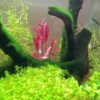Commonly known as the 'Ninja Shrimp', Caridina serratirostris has recently been reclassified as two independent but related shrimp by Dr Tim Page of Griffith University.
“The final factor in the separation of the Ninja shrimp from serratirostris is based on the length of the stylocerite according to De Man’s works. This element varies depending on the populations of Caridina serratirostris and of Caridina celebensis, the distinction between the two species was questioned more than once.â€
Preferred conditions:
Mean conditions from two collection sites (Northern Territory, Aus):
pH ranges from 6.5 to 8 depending on rainfall and time of year.
GH: 6 to 25
KH: Not detectable at either collection site.
Temperature: 24 to 27°C, some areas get as warm as 29°C.
Size:
1.8 - 2.4cm
Males tend to be smaller like most Caridina species.
Description:
As the name suggests these guys are characterised by the Caridina typical body shape but with a “serra†serrati or rough/serrated “rostris†rostrum. “19 to 26 spikes from which a long segment that comprises 6 to 8 spikes behind the orbitsâ€.
The colouration of the carapace is extremely variable and can range from red/orange through to red, brown and black in some specimens with areas of white or cream colouration on darker coloured specimens.
Activity:
Best in larger groups. They prefer a lower lit hardscape aquarium, or well shaded by plants, as this emulates their natural habitat more closely than a well lit manicured one. They generally seek hides or at least nooks during times of higher light. They are best observed under wide leafed or well grouped plants.
Caridina serratirostris can be found in areas of higher water flow rates and their stocky build and short periopods and antennae are testament to this feature.
Life span:
Around 18 months. Similar to most other freshwater crustaceans of this size.
Feeding:
Omnivorous and opportunistic, with a strong vegetarian aspect.
Dimorphism:
The females are generally larger than the males showing better colouration. Holes in the inside of the third pair of pleopods can be noted with some serious inspection.
This species uses an indirect type of reproduction that comprises larval stages in salt/brackish water, however successful reproduction entirely in freshwater regularly occurs.

